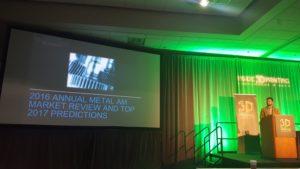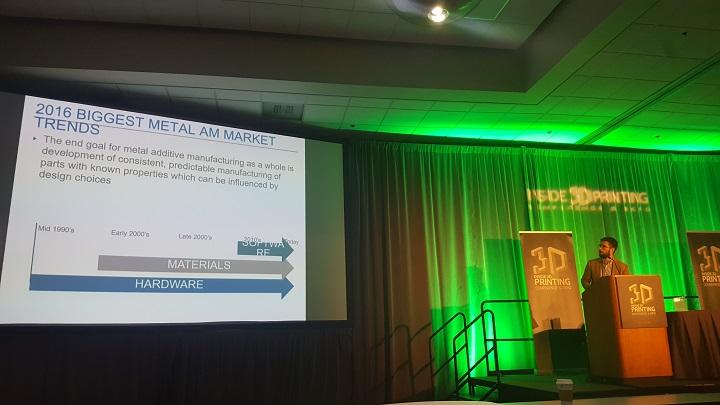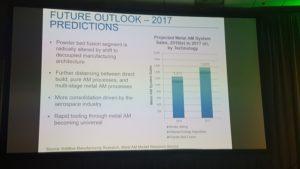Additive Manufacturing Research Examines Metal 3D Printing Industry: 2016 in Review, Predictions for 2017
With barely a week left before New Year’s, year-end nostalgia tends to rear its head; I think most of the world agrees, though, that it’s about time for 2016 to go gentle into that good night, as this past year has been globally tumultuous. As we all begin looking ahead to 2017, with hopes of ringing in a better world. predictions about what lies ahead are beginning to surface. Of course these sentiments resound as well across the 3D printing industry, as those interested and involved in additive manufacturing are of course also looking back at lessons and achievements from 2016 and looking ahead to what 2017 might bring on the business and technology fronts.
At Inside 3D Printing San Diego last week, Additive Manufacturing Research (AMR) lead analyst Scott Dunham spoke in an intriguing presentation: “2016 Annual Metal AM Market Review and Top 2017 Predictions“. In his session, Dunham — whose work we have been following closely as AMR continues to release monthly reports on markets in additive manufacturing — spoke to realistic views on market expectations.
“Personally, I would describe Hod’s outlook as extremely optimistic,” Dunham began, referencing Hod Lipson’s earlier keynote in which he presented his predictions for the next 25 years in 3D printing.
Striving for a realistic view of the fast-growing additive manufacturing industry, Dunham turned right to the research AMR works to analyze.
“The end goal for metal additive manufacturing as a whole is development of consistent, predictable manufacturing of parts with known properties which can be influenced by design choices,” Dunham said in his presentation.
As one of the key markets that AMR studies, trends in metal additive manufacturing represent a primary focus for both the company and, as the exponential rates of growth and adoption show, the industry as a whole. Dunham began by taking a look at the state of the industry as of 2016.
Growth in the metal AM segment has only recently started to truly take off, becoming more capable as well as more accessible in the areas of materials, software, and hardware alike. Among the biggest trends in metal AM visible in 2016 was the development of new materials, an area that has really taken off since the beginnings of work with stainless steel in the industry’s early days. Trends in materials are being driven by “new desires for these machines” as their capabilities and applications expand, requiring advanced materials that can handle the rising expectations. Additionally necessary to meet these expectations is enhanced software capable of handling precision and repeatability in intensive design. Developments have been in progress the longest in the hardware sector, which AMR points to as having been in the works since the 1990s, while it’s been since the early 2000s that the industry has begun to expand beyond stainless steel materials in metal AM, and only since around the 2010s that significant development has begun to shape software.
Dunham said:
“We haven’t really started to see a lot of significantly different or disruptive advances in metal additive manufacturing software until recently.”
New processes and new market participants are opening up the market. Dunham additionally noted the following trends in hardware:
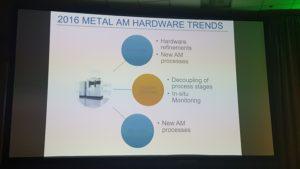 Productivity
Productivity- Hardware refinements
- New AM processes
- Process Efficiency
- Decoupling of process stages
- In-situ monitoring
Precision- New AM processes
“Current hardware evolution is seeking primarily to solve challenges associated with productivity and processing efficiency,” Dunham noted in his presentation. “The most significant trend currently underway is in the decoupling of processing steps in the powder bed fusion segment. Concept Laser, EOS, Sisma, and more are all exploring this as a next generation hardware concept.”
2016 saw a “significant uptick in the commercial development of new metal additive manufacturing processes,” as participants in the industry either combine elements of existing approaches or apply familiar concepts in completely new ways. Trends this year have been driven by the desire for flexibility in metal AM capabilities to meet a diverse set of potential adopters’ needs.
On the materials side, Dunham explained:
“We’re seeing a lot of new entrants in this supply chain with an eye toward additive manufacturing. We might see a little more fragmentation in the supply chain.”
With this fragmentation comes increasing investment in specialized production. Dunham noted that:
- Both gas and plasma atomization techniques can be tailored to favor AM
- This specialization is also applying some pricing pressure
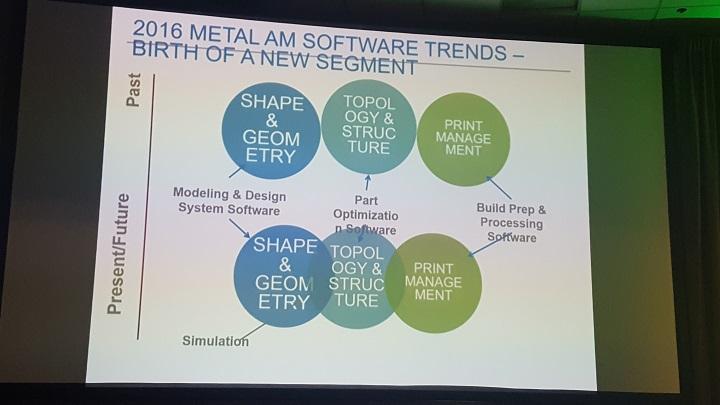 Trends in software include the “birth of a new segment,” as over the past year, “we have seen a significant commercial segment born through specialized metal AM additive manufacturing software.” Lines in tool categories are becoming blurred as many tools fall into print preparation software packages and incorporate combined features.
Trends in software include the “birth of a new segment,” as over the past year, “we have seen a significant commercial segment born through specialized metal AM additive manufacturing software.” Lines in tool categories are becoming blurred as many tools fall into print preparation software packages and incorporate combined features.
“A lot of these tools that are emerging — 3D Systems came out with 3DXpert, there are several out there focusing exclusively on simulation — they’re blurring the lines between the traditional structure of most 3D printing software,” Dunham explained. “The focus on simulation is what’s important in this trend for metal AM.”
Turning next to a quantitative review of metal AM in 2016, Dunham noted that in 2016, annual systems sold in this segment rose to 1,271 units from 995 units seen in 2015. While the majority this past year remained powder bed fusion technology, that segment did lessen its vice grip on sales as directed energy deposition and binder jetting technologies saw increased shares of the pie. Total overall growth projected in system sales was over 27% for 2016. For shipments of powders used in metal additive manufacturing, AMR projected that 2016 saw 1,220 tons shipped, up from 807 tons shipped in 2015. AMR noted growth across the board, and is predicting notable growth to come specifically in nickel alloys and aluminum.
Looking to 2016 as a whole, Dunham provided the following recap of the year in review:
- 2016 growth in adoption of metal AM was extremely promising given the large influx in year over year growth since 2013
- Total combined metal AM primary market size (hardware and materials) likely to exceed well over $900M in revenue worldwide for 2016 calendar year
- Strong growth across all technology segments, but hybrid manufacturing is growing very rapidly through laser cladding modules
- Stronger than average growth in powder shipments observed in aluminum and nickel alloys
Turning his attention to predictions for the future, Dunham and AMR expect to see rapid growth through 2025. We’re looking at a hardware segment of about $4 billion, with an overall more than $6 billion market for revenues from hardware and materials. In comparison, the market in 2016 is estimated to approach $1 billion for hardware and materials. Additional forecasts include:
- Powder bed fusion segment is radically altered by shift to decoupled manufacturing architecture
- Further distancing between direct build, pure AM processes, and multi-stage metal AM processes
- More consolidation driven by aerospace industry
- Rapid tooling through metal AM becoming universal
Dunham’s predictions paint a positive picture for the future of metal 3D printing — yes, perhaps a somewhat moderate view as compared to some more optimistic forecasts for the market, but even with some restraint in mind, we’re looking at a healthy sestupling of the size of the hardware/materials industry within the decade. With 2017 just around the corner, we’re all gearing up to see how the latest predictions will pan out for the industry. There’s no denying that metal additive manufacturing is gaining momentum across the board, and we’ll be following closely as the industry picks up some real steam. To keep up with the latest trends each month, you can learn more directly from Additive Manufacturing Research.
[All photos taken by Sarah Goehrke for 3DPrint.com]Subscribe to Our Email Newsletter
Stay up-to-date on all the latest news from the 3D printing industry and receive information and offers from third party vendors.
You May Also Like
New Report: Semiconductor Industry to See $1.4B in 3D Printing Revenues by 2032
“The semiconductor sector has become the most strategically significant area of global industry.” Truer words are hard to come by when it comes to the modern world, and they are...
Will Photonic-Crystal Lasers Revolutionize 3D Printing?
Powder bed fusion (PBF) for metals and polymers predominantly utilizes lasers as the primary heat source. Some directed energy deposition (DED) technologies also employ lasers, while various vat polymerization methods...
3D Printing Unpeeled: Orbex Investment, IndoMIM and HP, Ultrasonic Waves
INDO-MIM has bought three HP Metal Jet S100 printers, operating two in India and one in Texas. This is a win for HP because the company has deep experience in...
3D Printing Webinar and Event Roundup: April 21, 2024
It’s another busy week of webinars and events, starting with Hannover Messe in Germany and continuing with Metalcasting Congress, Chinaplas, TechBlick’s Innovation Festival, and more. Stratasys continues its advanced training...


